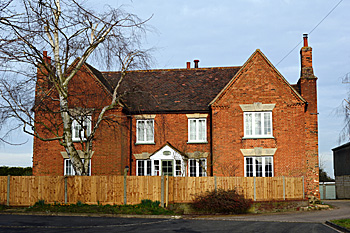26 High Street - Fowlers Farmhouse Meppershall

Fowler's Farmhouse March 2015
Fowler's Farmhouse, was listed by English Heritage as Grade II 'of special interest' in 1985. The listing describes the building as a Late 16th century house, reworked in the early 19th century. It is timber framed, some of which remains visible, but most of the walls are encased in red brick and clay tile rooves. The property is built in an H-plan in two storeys, it has a gabled central porch and a single storey lean to. The interior possesses wall framing and beams throughout and there is a surviving open fireplace.
In V. H. Chambers' Old Meppershall: a Parish History [Pamphlet 130MEP 7932] it states that the first known occupier of Fowler's Farm was George Fowler, son of George Fowler of Woodhall, yeoman, who died in 1739. When George's wife Margaret died in 1754, the house was under mortgage, and was presumably sold. Francis Fowler occupied this farm as well as the Hoo, between 1757 and 1784, at which point it was known as 'Town Farm'. Both of these farms were then taken over by Joseph Field, who was then followed by John Gregory Fox, who was in possession of the farm in the early 1800s. Before inclosure (in Meppershall, this was around 1853), the farm, comprising 86 acres, was owned by Frances Bell and occupied by Charles Pestell. Pestell remained in occupation of Fowler's Farmhouse until his death in 1869 (p.47).
In 1896 the owner of the farm was William Watson, who let the 96 acre plot, including homestead and farmland to Amos Simons. When the farm was then sold in 1916 there appears to have been some disagreement as the Simons family wished to retain the farm following the sale [Z740/86/4]. It appears this dispute was not resolved in the Simons' favour as we know from our records that Amos Simons auctioned off his farming stock and equipment later that year [Z720/258]. The majority of which was purchased by a Mr Ransom.
The Rating and Valuation Act 1925 specified that every building and piece of land in the country was to be assessed to determine its rateable value. The records from this act's enforcement suggest that Mr Ransom was involved also in the purchase of the farm and buildings, as at this time the building was owned by a William Ransom. By this point the farmhouse had been split into two separate properties. The smaller of the two was occupied by H Jepps. The building was of brick and tile comprising a parlour, living room and scullery with two bedrooms upstairs. Outside was a barn and an earth closet. The valuer noted that it was 'Nice, pretty garden, very small'. The second property next to the farmyard was rented by A Field) on a 5 year lease from 1922 at £42. Also of brick and tile, this larger house contained two parlours, a kitchen, small store room, three upstairs bedrooms and a cellar. Outside was a barn and an earth closet. Water for both properties was obtained from a pump [DV1/C160/41-2]
In 1970, the farmhouse along with a cottage homestead, yard garden and outbuildings passed by conveyance from Michael Henry Foster to Polehanger Farms Ltd [CCE 5323/1].